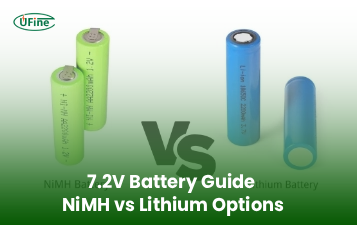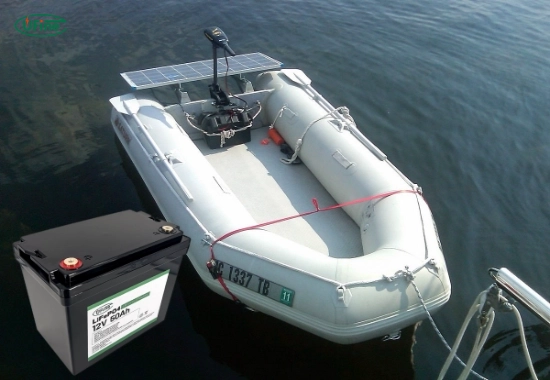
- Part 1. What is a trolling motor and why battery weight matters?
- Part 2. What defines a lightweight battery for trolling motors?
- Part 3. Why choose lightweight batteries for trolling motors?
- Part 4. Key features to look for in lightweight batteries for trolling motors
- Part 5. Understanding lightweight battery technology
- Part 6. Must-know facts about lightweight battery chargers
- Part 7. Comparing top brands for trolling motor batteries
- Part 8. The crossover between marine and outdoor battery tech
- Part 9. Maintenance tips to extend battery life
- Part 10. FAQs about lightweight batteries for trolling motors
If you’re looking for the best lightweight batteries for trolling motors, you’re likely aiming for a smoother, more efficient boating experience. What is the best lightweight battery pack for a trolling motor, and what features should you consider? In short, the best options combine high energy density, low weight, long life cycles, and consistent performance. This guide covers everything you need to know, from technology types to maintenance tips, ensuring you make a confident and informed purchase.
Part 1. What is a trolling motor and why battery weight matters?
A trolling motor is a small, quiet electric motor mounted on a boat to assist in precise navigation, making it particularly handy for fishing. It allows boaters to move silently through water without disturbing the environment or scaring away fish.
The battery powering this motor must be reliable, portable, and have a long lifespan. Many traditional deep-cycle batteries are heavy. These older models can weigh more than 60 pounds, significantly affecting the boat’s speed, balance, and maneuverability.
Using a lightweight battery for trolling motor applications reduces the overall weight load of your vessel. Less weight means better fuel efficiency if using a hybrid setup, improved handling, and easier transportation and installation. The benefits are clear for both recreational anglers and professionals.
Part 2. What defines a lightweight battery for trolling motors?
A lightweight trolling motor battery typically weighs under 30 pounds and is built using high-energy-density materials. The most common and effective type is Lithium Iron Phosphate (LiFePO4). These batteries provide consistent voltage output, long cycle life, and far less weight compared to traditional lead-acid batteries.
Key defining characteristics:
- High energy-to-weight ratio
- Compact size
- Long cycle life, often over 2000 charge cycles
- Low self-discharge rate, ideal for seasonal use
- Enhanced safety with built-in Battery Management Systems (BMS)
These batteries are specifically designed for marine applications, making them an ideal choice for trolling motors.
Part 3. Why choose lightweight batteries for trolling motors?
Boaters today prioritize efficiency, ease of use, and sustainability. A range of practical advantages drives the shift toward lightweight lithium battery packs:
1. Portability
Lightweight batteries are easy to carry, install, and remove. This is particularly useful for those who trailer their boats or need to swap batteries between outings.
2. Extended run times
Lithium batteries maintain a higher voltage for longer periods. This means your trolling motor will run more efficiently throughout the discharge cycle, giving you more time on the water.
3. Faster recharge rates
A lightweight battery charger designed for lithium cells can significantly reduce charging time. Some models fully recharge in 4 to 6 hours, compared to 10 to 12 hours for lead-acid alternatives.
4. Longer lifespan
Most lithium batteries last for 5 to 10 years or over 2000 charge cycles. This makes them more cost-effective in the long run despite a higher upfront investment.
5. Improved boat performance
Reducing battery weight helps improve your boat’s speed, handling, and motor responsiveness. Less drag means less strain on the motor, enhancing efficiency.
6. Eco-friendly and safe
LiFePO4 batteries contain no toxic heavy metals or acid. They are safer for marine environments and easier to recycle.
Part 4. Key features to look for in lightweight batteries for trolling motors
When selecting a lightweight battery for trolling motor use, focus on the following essential features:
Battery Type- LiFePO4 (Lithium Iron Phosphate): The top choice for marine applications due to safety, weight, and longevity.
- AGM (Absorbent Glass Mat): Maintenance-free and spill-proof, but heavier than lithium.
- Gel batteries: Safer than flooded lead-acid but still relatively heavy.
- 50Ah to 100Ah batteries are common.
- Higher Ah ratings provide longer run time.
- Most trolling motors operate on 12V, but some larger models require 24V or 36V systems.
- Ensure your battery configuration matches your motor’s requirements.
- A truly lightweight battery should weigh under 30 pounds.
- Ultra-light options can be as low as 17-20 pounds.
- A built-in BMS protects against overcharging, overheating, over-discharging, and short-circuiting.
- Look for IP65 or IP67 ratings to ensure water resistance in marine conditions.
- Lithium batteries generally operate effectively between -20°C to 60°C, making them versatile in different climates.
- A quality battery should offer a 5 to 10-year warranty and responsive customer service.
Part 5. Understanding lightweight battery technology
The backbone of modern lightweight battery technology is the LiFePO4 chemistry. It offers a stable molecular structure, making the battery resistant to overheating and combustion. This chemistry also supports deep discharges without damaging the battery’s internal components.
Other advantages include:
- Flat voltage curve: Maintains steady performance until the battery is nearly depleted.
- Low internal resistance: Supports high current loads without voltage sag.
- No memory effect: Can be charged at any time without reducing lifespan.
These features are essential in fluctuating marine environments where reliability is key.
Part 6. Must-know facts about lightweight battery chargers
A lightweight battery charger for lithium batteries must be compatible with LiFePO4 chemistry. Key features to look for include:
- Automatic shutoff to prevent overcharging
- Multi-stage charging (bulk, absorption, float)
- Temperature monitoring to avoid overheating
- Portability for on-the-go use
Avoid using traditional lead-acid chargers with lithium batteries unless the charger is specifically labeled as LiFePO4-compatible.
Part 7. Comparing top brands for trolling motor batteries
When choosing the best batteries for trolling motors lightweight, it helps to compare top brands based on performance, weight, and customization options.
| Brand | Weight | Battery Type | Notable Features |
|---|---|---|---|
| Battle Born | ~29 lbs | LiFePO4 | 100Ah, BMS, 10-year warranty, well-known in marine use |
| Dakota Lithium | ~17 lbs | LiFePO4 | 54Ah, waterproof, fast charge, long cycle life |
| Ampere Time | ~24 lbs | LiFePO4 | 100Ah, budget-friendly, compact design |
| Mighty Max | ~23 lbs | AGM | 55Ah, maintenance-free, good for budget buyers |
| UFine Battery | Custom | LiFePO4 | Highly customizable lithium packs, OEM/ODM available, tailored to voltage, capacity, and case size |
UFine Battery stands out in the market by offering custom-built lithium battery solutions specifically for trolling motors. Whether you need a compact 12V 50Ah pack or a high-capacity 36V system, UFine can customize the battery to fit your boat’s space, performance, and mounting requirements. Their engineering team works closely with clients to deliver batteries that meet precise technical specifications, including waterproofing, temperature resistance, and discharge rates.
Part 8. The crossover between marine and outdoor battery tech
The rise of the lightweight battery leaf blower and other cordless tools has accelerated advancements in battery technology. The same compact, high-drain lithium cells used in power tools are now being adapted for marine applications.
This crossover has led to:
- Lower production costs
- Higher power density
- Improved safety standards
As a result, boaters now have access to batteries that are not only lighter and stronger but also more affordable and widely available.
Part 9. Maintenance tips to extend battery life
Maintaining your lightweight trolling motor battery ensures performance and longevity. Here are practical tips to protect your investment:
- Charge after every use, even partial discharges
- Avoid full discharges below 10% to preserve cycle life
- Use proper chargers with auto-shutoff and LiFePO4 compatibility
- Inspect terminals regularly for corrosion or loose connections
- Store in a cool, dry place when not in use
- Disconnect the battery during long storage periods
By following these steps, you can significantly extend your battery’s lifespan.
Part 10. FAQs about lightweight batteries for trolling motors
How long can a lightweight battery run a trolling motor?
A 100Ah lightweight lithium battery can typically run a 55 lb thrust trolling motor for 4 to 6 hours under normal conditions. Runtime depends on motor speed, water resistance, and weather.
Are lightweight batteries safe for marine environments?
Yes, especially lithium options with LiFePO4 chemistry. They include built-in safety features and are resistant to overheating and moisture.
Can I use a car battery for my trolling motor?
No, car batteries are not designed for deep discharges. They will degrade quickly and may damage your trolling motor.
Do I need a special charger for lithium batteries?
Yes, use a charger compatible with LiFePO4 batteries. Traditional lead-acid chargers may overcharge or damage them.
What makes UFine Battery a good choice for trolling motors?
UFine Battery offers custom lithium packs designed to meet the specific requirements of your boat. Their expertise in marine battery design ensures high performance, safety, and durability.
Related Tags:
More Articles

NiMH vs Lithium 7.2V Battery and Charger: Which Is Better?
Compare 7.2V NiMH vs Lithium batteries and chargers in 2025. Learn runtime, weight, charging, lifespan, and cost to choose the best for your device.
How to Choose the Right 7.2V Battery and Charger for Your Device?
Learn how to choose the right 7.2V battery and charger for optimal performance, safety, and longevity across RC, tools, medical, and industrial devices.
Big Square Battery Safety Standards You Must Know
Learn key safety standards for big square batteries to avoid fire risks, shipping delays, and compliance issues in EV, industrial, and energy storage projects.
Big Square Battery Applications in Solar & Industrial Equipment
Big square batteries deliver high capacity, stable output, and long life for solar, industrial, and backup power. Explore key uses and advantages.
Big Square Battery vs Cylindrical Battery: Complete 2025 Guide for EVs, ESS & Industrial Devices
Choosing the right battery is key for designers and engineers. Compare big square vs cylindrical batteries to find the best fit for your application.



